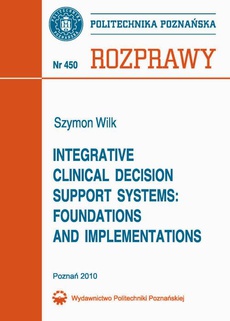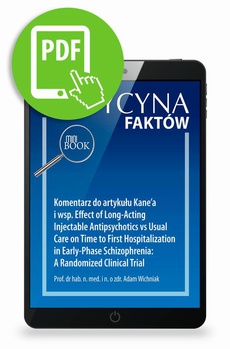POLECAMY

-20%
Integrative clinical decision support systems: foundations and implementations
Autor:
Wydawca:
Format:
The book is concerned with theoretical and methodological foundations of clinical decision support systems (CDSSs), i.e., systems designed to help healthcare professionals make clinical decisions. It is focused on patient-specific CDSSs that help physicians make diagnostic and treatment decisions directly at the point of care and it addresses theoretical and methodological aspects of their design and implementation. The book introduces the notion of integrative clinical decision support that covers all tasks from the clinical decision making process and proposes a theoretical architecture for integrative CDSSs (ICDSSs), called the MET3 architecture. The architecture combines the principles of multi-agent systems with ontology-driven design in order to distribute the complex support functionality among independent entities and to represent different types of clinical knowledge in form of ontological models. The MET3 architecture is a theoretical solution that provides a common platform for other methodologies, algorithms and frameworks proposed in this book.
Responding to the requirement for comprehensive and accurate diagnostic decision models, modifications of rule induction algorithms rooted in rough set theory have been proposed. These algorithms allow generating robust decision rules from inconsistent and incomplete data. The book also describes their combination that successfully deals with imbalanced distribution of decision classes that is typical for clinical data. Addressing the need for accurate and efficient retrieval of relevant clinical evidence, a framework for enhanced indexing and automatic retrieval of evidence-based documents (systematic reviews of clinical trials) has been introduced. The framework allows for retrieval of documents that are relevant in the current context of a patient-physician encounter. Retrieved evidence augments diagnostic and treatment suggestions and enables physicians to make more informed decisions. Finally, principles guiding the design of interactions in CDSSs and ICDSSs have been provided. These principles have been derived from task-oriented and user-oriented design approaches, and when formulating them, special attention was paid to modern mobile computing platforms, including handhelds devices. The MET3 architecture and the remaining proposed methodological solutions were successfully validated in practice. Proof-of-concept ICDSSs for two clinical problems (pediatric scrotal pain and asthma exacerbations) were developed, diagnostic decision models for these problems were constructed, and finally the indexing and retrieval framework for asthma exacerbations was implemented. Results of this verification, as well as experience with designing and running a clinical trial of a CDSS, is described in details in this book.
| Rok wydania | 2010 |
|---|---|
| Liczba stron | 138 |
| Kategoria | Inne |
| Wydawca | Wydawnictwo Politechniki Poznańskiej |
| ISBN-13 | 978-83-7143-969-8 |
| Numer wydania | 1 |
| Język publikacji | polski |
| Informacja o sprzedawcy | ePWN sp. z o.o. |
Ciekawe propozycje
Komentarz do artykułu Kane’a i wsp....
do koszyka
Multiple Criteria Decision Making '12
do koszyka
The Valley of Decision
do koszyka
WHITE NOISE: Strategic Decision Game
do koszyka
Creativity Support Systems. SE 88
do koszyka
Spis treści
| Acronyms and abbreviations | 5 |
| Abstract | 7 |
| 1. Scope and objectives | 9 |
| 1.1. Scope | 9 |
| 1.2. Motivations | 10 |
| 1.3. Objectives | 12 |
| 1.4. Book organization | 14 |
| 1.5. Acknowledgments | 14 |
| 2. An architecture for an ICDSS and its theoretical foundations | 15 |
| 2.1. Introduction | 15 |
| 2.2. Conceptual model of decision making implying the MET3 architecture | 16 |
| 2.3. Related research on patient-specific CDSSs | 17 |
| 2.4. Methods for developing the MET3 architecture | 19 |
| 2.5. The MET3 architecture | 21 |
| 2.5.1. Requirements | 21 |
| 2.5.2. Goal model | 23 |
| 2.5.3. Domain ontology | 24 |
| 2.5.4. Agent model | 26 |
| 2.6. Discussion | 28 |
| 3. Methodologies for constructing diagnostic decision models | 33 |
| 3.1. Introduction | 33 |
| 3.2. Rough set theory | 35 |
| 3.2.1. Handling inconsistent and incomplete objects | 35 |
| 3.2.2. Identifying important condition attributes and assessing their information value | 38 |
| 3.2.3. Discovering rules in decision tables | 40 |
| 3.2.4. Using decision rules to classify new objects | 45 |
| 3.3. Proposed methods for induction of robust decision rules | 47 |
| 3.3.1. Modifications of existing rule induction algorithms | 47 |
| 3.3.2. Combination of LEM2* and EXPLORE* to handle imbalanced data | 50 |
| 3.4. Experimental evaluation of the proposed methods on clinical data | 52 |
| 3.5. Discussion | 55 |
| 4. A framework for indexing and retrieval of context-specific evidence | 57 |
| 4.1. Introduction | 57 |
| 4.2. Related research | 59 |
| 4.3. The Cochrane Library | 61 |
| 4.4. Proposed methods | 62 |
| 4.4.1. Design of the indexing and retrieval framework.62 | |
| 4.4.2. Phase 1: identification of core index concepts | 65 |
| 4.4.3. Phase 2: indexing of evidence-based documents | 66 |
| 4.4.4. Phase 3: retrieval of evidence-based documents | 67 |
| 4.5. Discussion | 69 |
| 5. Principles of designing interactions for an ICDSS | 73 |
| 5.1. Introduction | 73 |
| 5.2. Related research on interactions in CDSSs | 74 |
| 5.3. Methodological foundations of interaction design | 75 |
| 5.3.1. Framework of interactions | 75 |
| 5.3.2. Scenario-based design methodology | 76 |
| 5.3.3. Object-Action-Interface model | 76 |
| 5.3.4. Eight Golden Rules of Interface Design | 77 |
| 5.4. Proposed principles for interactions in ICDSSs | 77 |
| 5.5. Discussion | 82 |
| 6. Practical applications of the proposed methodologies | 85 |
| 6.1. Introduction | 85 |
| 6.2. Implementation of the MET3 architecture | 85 |
| 6.3. Generic process of constructing diagnostic decision models | 87 |
| 6.4. Construction of the diagnostic model for pediatric scrotal pain | 89 |
| 6.4.1. Description of the clinical problem | 89 |
| 6.4.2. Collected retrospective data | 90 |
| 6.4.3. Development of possible decision models | 91 |
| 6.4.4. Evaluation of selected decision models | 93 |
| 6.5. Construction of the diagnostic model for pediatric asthma exacerbations | 94 |
| 6.5.1. Description of the clinical problem | 94 |
| 6.5.2. Collected retrospective data | 95 |
| 6.5.3. Development of possible decision models | 98 |
| 6.5.4. Evaluation of selected decision models | 99 |
| 6.6. Implementation of the evidence indexing and retrieval framework for pediatric asthma exacerbations | 100 |
| 6.6.1. Identification of core index concepts | 100 |
| 6.6.2. Indexing evidence-based documents | 102 |
| 6.6.3. Retrieving evidence-based documents | 104 |
| 6.6.4. Evaluation of the automatic indexing | 105 |
| 6.7. Discussion | 107 |
| 7. Practical evaluation of a CDSS | 109 |
| 7.1. Introduction | 109 |
| 7.2. Methods | 111 |
| 7.2.1. Trial design and implementation | 111 |
| 7.2.2. Patient enrollment and follow-up | 113 |
| 7.2.3. Outcome measures and analysis | 114 |
| 7.3. Results | 115 |
| 7.3.1. Enrolled patients | 115 |
| 7.3.2. Accuracies of MET2-AP and physicians | 116 |
| 7.3.3. Inter-observer agreement | 116 |
| 7.4. Discussion | 118 |
| 8. Conclusions | 121 |
| 8.1. Results and contributions | 121 |
| 8.2. Future research directions | 122 |
| References | 123 |
| Streszczenie | 137 |
























